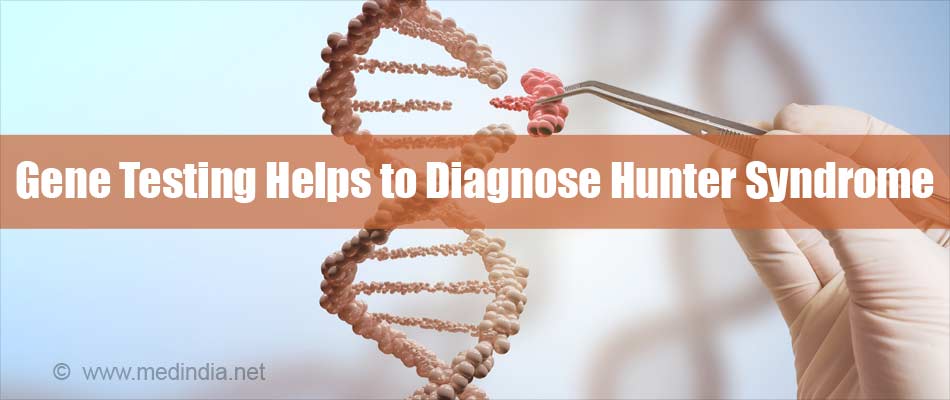- Hunter syndrome - (http://www.mayoclinic.org/diseases-conditions/hunter-syndrome/home/ovc-20165659)
- Hunter syndrome - (https://medlineplus.gov/ency/article/001203.htm)
- Mucopolysaccharidosis type II - (https://ghr.nlm.nih.gov/condition/mucopolysaccharidosis-type-ii)
- Scarpa M. Mucopolysaccharidosis Type II. 2007 Nov 6 [Updated 2015 Mar 26]. In: Pagon RA, Adam MP, Ardinger HH, et al., editors. GeneReviews® [Internet]. Seattle (WA): University of Washington, Seattle; 1993-2017.
- Narayanan DL et al. Hunter syndrome in northern India: Clinical features and mutation spectrum. Ind Ped. 2016;53:134-136.
- Guffon N et al. Diagnosis, quality of life, and treatment of patients with Hunter syndrome in the French healthcare system: a retrospective observational study. Orph J Rare Dis. 2015;10:43.
- Burton BK, Giugliani R. Diagnosing Hunter syndrome in pediatric practice: practical considerations and common pitfalls. European Journal of Pediatrics. 2012;171(4):631-639. doi:10.1007/s00431-012-1703-y.
- Giugliani R, Villarreal MLS, Valdez CAA, et al. Guidelines for diagnosis and treatment of Hunter Syndrome for clinicians in Latin America. Genetics and Molecular Biology. 2014;37(2):315-329.
What is Hunter Syndrome?
Hunter syndrome is a rare inherited disorder that results from the absence or malfunctioning of a lysosomal enzyme (protein) due to mutations in the IDS gene. The enzyme is iduronate-2-sulfatase. Hunter syndrome is a debilitating condition with variable rates of progression.
The function of iduronate-2-sulfatase is to break down long chains of glycosaminoglycans (sugars; former name: mucopolysaccharides). The defective enzyme causes glycosaminoglycans to accumulate, which damages multiple organs.
Hunter syndrome belongs to a disease group called mucopolysaccharidoses and is hence also known as mucopolysacchharidosis II or MPS II.
Hunter syndrome is predominantly observed in males with an incidence of 1 in 100,000 to 1 in 170,000.
What are the Types of Hunter Syndrome?
Based on the age of onset, Hunter syndrome is either mild or severe. The mild form (IDS gene variant: c.1122C>T) develops in children aged 4.3 years or more while the severe form (lack of functional enzyme) develops in children aged 2.5 years and above.
What are the Causes of Hunter Syndrome?
Hunter syndrome is an inherited, rare, X-linked recessive lysosomal storage condition. The affected chromosome is passed down from the mother who does not show any symptoms due to the presence of a normal chromosome in the chromosome pair. Boys who inherit the affected chromosome display symptoms. This explains the predominance of the condition in males.
What are the Symptoms and Signs of Hunter Syndrome?
Although children with Hunter syndrome seem to be normal at birth, characteristic symptoms begin to appear between the ages of 2 and 4. These symptoms vary based on the age of onset and the severity of the condition. The symptoms manifest as a continuum between the severe and the attenuated versions of the syndrome.
- Nose becomes broad
- Tongue is enlarged
- Cheeks become enlarged and rounded
- Lips thicken
- Voice becomes hoarse due to enlarged vocal cords
- Liver and spleen become enlarged (hepatosplenomegaly)
- Fluid builds up in the brain (hydrocephalus)
- Hernia (soft extensions or out-pouching) develops in the lower abdomen (inguinal hernia) or around the belly button (umbilical hernia)
- Enlarged head (macrocephaly)
- Hearing loss
- Thick non-elastic skin
- Frequent infections in the ear
- Characteristic skin outgrowths that look like pebbles
- Heart valve issues
- Aggression in behavior
- Stiffness in joints
- Delay in talking and walking
- Growth is restricted
- Carpal tunnel syndrome
- Retinal issues leading to compromised vision
- Compressed and damaged spinal cord

In severe cases, the intellectual and mental capabilities are compromised (cognitive impairment) along with delayed development (developmental regression), which is not observed in mild cases of Hunter syndrome.
How do you Diagnose Hunter Syndrome?
Diagnosing Hunter syndrome involves detecting the clinical symptoms, the molecular features and the biochemical characteristics of the condition.
Clinical diagnosis: A complete family and medical history of the patient is required. Some of the characteristic symptoms observed in babies before the age of 6 months are enlarged spleen and liver, persistent infections of the ear, and hernia. Other symptoms include joint and skeletal bone issues, respiratory problems, and facial distortions. Prior surgical history of the child should be taken since Hunter syndrome is often detected in children who have undergone surgery.
Gene testing: Detecting mutations in the IDS gene is useful but is not required for diagnosis. Families should go for genetic counseling if mutations are detected. Gene testing helps to detect female carriers in a family. Prenatal enzyme assay testing of the IDS gene is useful to diagnose affected fetuses. In a case study in North India, it was observed that mutation testing greatly helped in identifying carrier females as well as affected fetuses.

Biochemical testing:
- Enzyme assay: Detecting enzyme activity is useful to understand deficiency in the IDS enzyme. This is an effective tool to diagnose Hunter syndrome although it cannot detect carriers of IDS gene mutations.
- Urinary GAG test: This assay measures the total levels of glycosaminoglycans (GAG) or long chain sugars in the urine. However, this assay is not very sensitive with many false-negative data.
Laboratory tests are highly effective in confirming the diagnosis of Hunter syndrome since there are many symptoms that are common between different conditions of the mucopolysccharidoses group.
Other diagnostic tests for some of the symptoms are as follows:
- Auditory test
- Testing lung function
- Echocardiogram
- Assessing development
- MRI of the head and cervix
- Sleep function test
- Examination of the eye
- Genetic consultation
These tests should be performed annually as a surveillance strategy to monitor the patients.
How do you Manage and Treat Hunter Syndrome?
Following diagnosis, patients are referred to a clinical geneticist to initiate immediate treatment. Multidisciplinary collaboration is required to manage Hunter syndrome. The family physician or pediatrician helps the family and the patient to coordinate meetings and interactions with multiple specialists (ophthalmologist, anesthesiologist, neurosurgeon, orthopedic specialist, speech therapy, physiotherapy, dentistry, behavioral therapy).
There are different methods of treatment involved in dealing with the individual issues related to Hunter syndrome:
- Replacement of the cardiac valve
- Repair of inguinal hernia
- Shunting of fluid accumulation in the brain
- Tonsillectomy
- Adenoidectomy
Enzyme replacement therapy (ERT): A manufactured (recombinant) form of iduronate-2-sulfatase, idursulfase (ElapraseÒ), was approved in 2006 to treat individuals with the mild form of Hunter syndrome, and it is now approved in over 40 countries. Except for cognitive impairment, ERT appears to improve other symptoms if patients are treated early. However, when ERT is treated following delayed onset of symptoms, it may not be as effective. Some of the side effects are fever, rash, and headaches.

Hematopoietic stem cell transplantation (HSCT): This particular form of treatment has shown benefits in other MPS conditions. However, benefits of HSCT in MPS II are yet to be confirmed. The idea behind the transplant (bone marrow or umbilical cord blood) is to infuse sufficient enzyme activity to slow down or arrest the progression of the condition.
What is the Prognosis of Hunter Syndrome?
Patients with the mild form of Hunter syndrome can live between 20 to 60 years. Patients with the severe form may live anywhere between 10 and 20 years.







